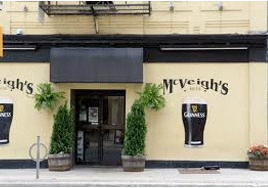Eric Morse –
When William Jenkins first came to Toronto in the mid-90s with a Masters’ degree from University College, Dublin, one of the first watering holes he visited was McVeigh’s at Richmond and Church. He’d already heard the stories.
“I was highly impressed with the guys with the red hair in the corner with the banjos playing Irish Republican songs. I then realized that they were all from Kingston, Ontario, but they looked as if they could be from West Belfast.”
That wasn’t really what impelled him to write the doctoral thesis or the book that followed.

Historian William Jenkins studies the Irish diaspora.
This past Nov. 5, Distillery District resident Jenkins, now director of the graduate program in history and associate professor in the Department of Geography at York, released his first book: Between Raid and Rebellion, comparing the Irish emigrant experiences in Buffalo NY and Toronto from the Fenian Raids of 1866-67 to the Easter Rising in Dublin of 1916.
“I didn’t come with a specific intention of writing a book on the Irish diaspora,” Jenkins recounts. “But the book originates in a doctoral thesis for University of Toronto. As I got to know Toronto and as I got to know the region, I realized that they had both contained substantial populations of Irish in the 19th century following the famine emigrations after 1847. I became aware that there was a very substantial Protestant component here—there were many Orange mayors in Toronto for instance—which didn’t exist in Irish American colonies. Not only the difference in jurisdictions of course; there were quite different sorts of Irish in Buffalo and Toronto. I felt there were things to be learned about the differences between US and Canadian Irish in the 19th century.”
After receiving his PhD—which had focussed on economic and social comparisons between the two communities—in 2001m, Jenkins realized that a book could be made more interesting, and more publicly accessible, by building in the political experiences of each settlement.
Jenkins explains that the two settlements were different in almost every way; the Toronto Irish a majority Ulster and Protestant, the Buffalo Irish Munster and Catholic. (He notes that although the post-famine emigrations to Toronto caused a bulge in the number of southerners arriving, the long-term pattern remained Protestant.) The Toronto Protestants tended to arrive in a more prosperous and literate condition than their southern counterparts, thus giving them a head start, and that tendency in immigration lasted right through to the early 20th century.
“The regional origins in Ireland do matter. You had a substantial presence of Northern Ireland Protestants in Toronto. The Irish Catholics that you found in Toronto are coming from different parts of Ireland; the Buffalo Irish are overwhelmingly Catholic and if you look at their regional origins you’ve got them coming from the mostly southwestern counties where there is more subsistence-type farming and higher levels of illiteracy; places that were much more scarred by the potato famine than the north-east.”
With the book in print, Jenkins is looking to narrow his focus a little.
“There are certain streets in Toronto that became known—or notorious—through their populations and the presence of their populations in the local courthouse. The over-representation of the Irish and the Catholic Irish in particular in the crime statistics in the 1850s and 1860s is quite striking.”
Jenkins compares the reputations of certain neighbourhoods of the time—some remarkably small—with the reputations that some current (and much larger)  neighbourhoods have as centres of crime. (“Profiling” is not new in the world, nor in Toronto, nor has it always been colour-based.)
neighbourhoods have as centres of crime. (“Profiling” is not new in the world, nor in Toronto, nor has it always been colour-based.)
One example Jenkins cites as “probably the most notorious street in the police court columns of the day” is a small 2-block den of iniquity originally known as March St. “Even before the Famine, March St. had acquired a reputation,” says Jenkins, “It had an ‘Erin’s Home’ tavern and all of the riotry to go with it.”
Around 1850, March St became Stanley St, and then—in 1876—Lombard St. “I want to write a little book about Stanley St. between the 1830s and the 1880s, when you see that population begin to unravel and businesses move in. I think there’s enough material about families, characters and the behaviour of the local population (and the Toronto police court) to make it fascinating social history. As you know, it’s only two blocks long…”
Between Raid and Rebellion is published by Queen’s University Press. For information, visit www.mqup.ca.
 TheBulletin.ca Journal of Downtown Toronto
TheBulletin.ca Journal of Downtown Toronto

